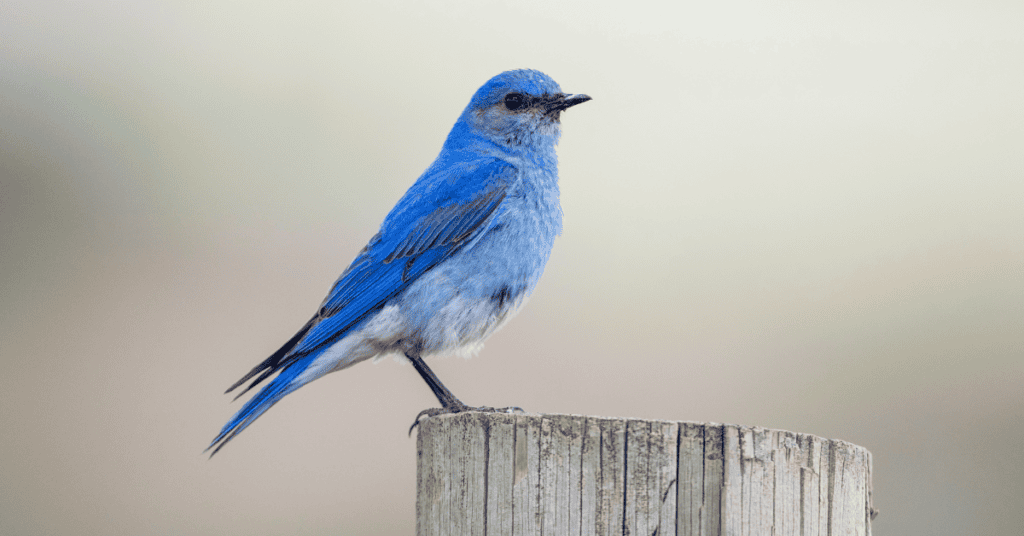Birdwatching isn’t just for the ultra-patient or wildlife enthusiasts with fancy binoculars—it’s a front-row seat to nature’s most vibrant performers. Blue birds, with their eye-catching feathers and lively personalities, have a way of making even casual glances outdoors feel like a discovery. Whether you’re spotting them from your porch, apartment window, or on a quiet trail, these 14 species prove that birdwatching is cooler than you think.
1. Eastern Bluebird

Listen to a male Eastern Blue Bird here:
recording in Florida from Patrick J. Blake, XC712412. Accessible at www.xeno-canto.org/712412.
- Appearance: Bright blue with a reddish-orange chest; males are more vibrant.
- Habitat: Open areas near trees, like meadows and parks.
- Diet: Summer: insects like grasshoppers; Winter: berries.
- Attract Them: Install nest boxes with small holes and plant native berry bushes.
- Fun Fact: These social birds live in small family groups and have a cheerful warbling song.
LEARN WHAT TO PLANT FOR ATTRACTING SONGBIRDS
attract more songbirds, with these awesome ideas!
2. Mountain Bluebird

- Appearance: Males are sky-blue; females are gray-brown with blue accents.
- Habitat: Open spaces like meadows and prairies in western North America.
- Diet: Summer: insects; Winter: berries.
- Attract Them: Place nest boxes in open areas; offer mealworms.
- Fun Fact: They migrate south for winter but may stay if food is available.
3. Western Bluebird

- Appearance: Males have bright blue feathers and rusty-orange chests; females are muted grayish-blue.
- Habitat: Open woodlands, meadows, and suburban areas in western North America.
- Diet: Insects, worms, and berries.
- Attract Them: Install bluebird houses or plant berry-producing shrubs.
- Fun Fact: They sing a soft “chur-chur” song and often flock in winter.
4. Blue Jay

Sue Riffe, XC841327. Accessible at www.xeno-canto.org/841327.
- Appearance: Bright blue with white and black markings and a crest.
- Habitat: Forests, parks, and suburban areas.
- Diet: Nuts, seeds, insects, fruits, and small animals.
- Attract Them: Provide peanuts or sunflower seeds at bird feeders.
- Fun Fact: These clever birds mimic hawks to scare other birds.
5. Indigo Bunting

Bill Grantham, XC905264. Accessible at www.xeno-canto.org/905264
- Appearance: Males are brilliant blue; females are brown.
- Habitat: Fields and woodland edges.
- Diet: Seeds, buds, berries, and insects.
- Attract Them: Offer nyjer or millet seeds at feeders.
- Fun Fact: They migrate at night, navigating by the stars.
6. Tree Swallow

Recording from Thomas Magarian, XC540308. Accessible at www.xeno-canto.org/540308
- Appearance: Shiny blue-green back with white underparts.
- Habitat: Near water, like ponds or lakes.
- Diet: Flying insects and berries.
- Attract Them: Provide nest boxes near open fields.
- Fun Fact: These birds gather in large flocks during migration.
7. Purple Martin

Here the Purple Martin
Richard E. Webster, XC940535. Accessible at www.xeno-canto.org/940535.
- Appearance: Males are glossy blue-purple; females are gray and purple.
- Habitat: Open areas near water.
- Diet: Insects caught mid-air.
- Attract Them: Install multi-room martin houses.
- Fun Fact: They migrate to South America for the winter.
8. Barn Swallow

- Appearance: Deep blue back with a forked tail.
- Habitat: Open areas near water, like farmlands.
- Diet: Insects caught in mid-air, occasionally berries
- Attract Them: Look for their mud nests under eaves or bridges.
- Fun Fact: They’re welcome guests to farmers, eating crop-damaging pests.
9. Cerulean Warbler

- Appearance: Sky-blue back with white belly and dark streaks.
- Habitat: High treetops in mature forests.
- Diet: Insects, especially larval stages.
- Attract Them: Support forest conservation and plant native trees.
- Fun Fact: Their populations are declining due to habitat loss.
10. Blue Grosbeak

- Appearance: Males are deep blue with reddish-brown wing bars; females are brown.
- Habitat: Open woodlands and shrubby areas.
- Diet: Insects and seeds.
- Attract Them: Plant shrubs or offer millet.
- Fun Fact: They sing a rich, warbling song from high perches.
11. California Scrub Jay

Lance A. M. Benner, XC335899. Accessible at www.xeno-canto.org/335899.
- Appearance: Blue head, wings, and tail; gray back; white chest.
- Habitat: Oak woodlands and suburban areas in the western U.S.
- Diet: Insects (especially moth catapillars), nuts, seeds, small animals, and fruits.
- Attract Them: Provide berries, insects, or sunflower seeds.
- Fun Fact: These intelligent birds form strong pair bonds.
12. Steller’s Jay

- Appearance: Deep blue body with a black crest. (one of the many examples of blue and black birds)
- Habitat: Forests of western North America.
- Diet: Nuts, seeds, berries, insects, and sometimes small animals.
- Attract Them: Offer peanuts or sunflower seeds.
- Fun Fact: They’re bold birds, often stealing food from picnics!
13. Lazuli Bunting

- Appearance: Males are bright blue with an orange chest; females are brownish.
- Habitat: Open woodlands and brushy fields.
- Diet: Seeds and insects.
- Attract Them: Offer sunflower seeds or millet.
- Fun Fact: Their cheerful, warbling songs brighten summer days.
14. Verditer Flycatcher

- Appearance: Bright sky-blue, copper blue, with a small, pointed beak.
- Habitat: Forests and woodlands in Asia.
- Diet: Flying insects and berries
- Attract Them: Look for them perched on branches, hunting bugs.
- Fun Fact: Their hunting style is called “sally-and-return.”